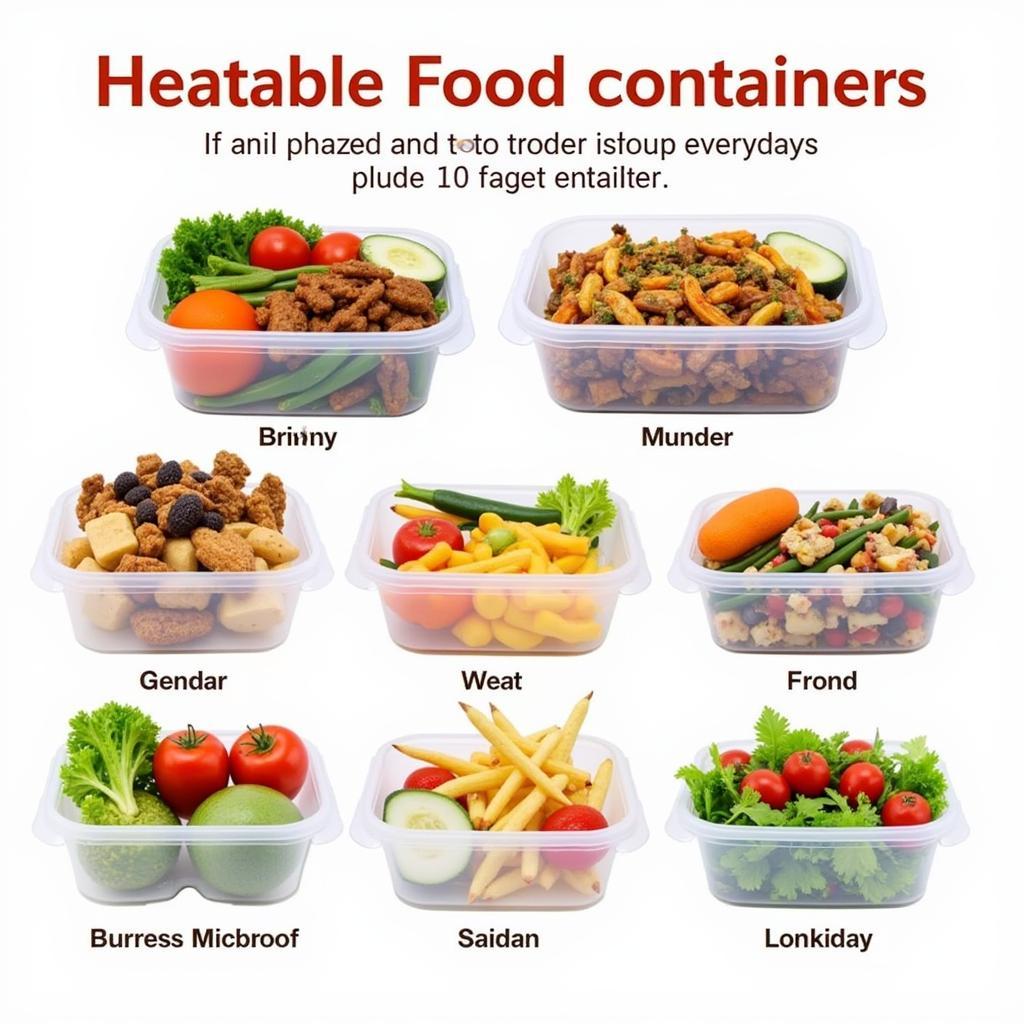Heatable Food Containers are essential for anyone who enjoys taking home-cooked meals on the go, reheating leftovers, or meal prepping. Choosing the right container can make all the difference in food safety, convenience, and even the taste of your food. This comprehensive guide dives deep into the world of heatable food containers, exploring everything from material choices to safety precautions.
Choosing the Right Heatable Food Container Material
Selecting the right material for your heatable food containers is crucial. Different materials offer varying benefits and drawbacks, including heat resistance, durability, and potential health impacts. Let’s break down the most common options:
-
Glass: Glass containers are a popular choice for their non-reactivity with food. They are oven-safe, microwave-safe (without lids), and often dishwasher-safe, making them versatile and easy to clean. However, glass is heavier and more prone to breakage than other materials.
-
Plastic: Plastic containers offer lightweight portability and are less likely to shatter. However, not all plastics are created equal. Look for BPA-free options and ensure the container is labeled as microwave-safe and dishwasher-safe. Some plastics can leach chemicals into food when heated, so careful selection is essential.
-
Silicone: Silicone containers are flexible, collapsible for easy storage, and often microwave-safe and dishwasher-safe. They are a good alternative to plastic and can withstand high temperatures. However, some silicone containers can retain food odors.
-
Stainless Steel: Durable and long-lasting, stainless steel food containers are excellent for both hot and cold food. They are typically oven-safe and often dishwasher-safe. However, they are not microwave-safe.
Ensuring Food Safety with Heatable Food Containers
Food safety is paramount when using heatable food containers. Here are some crucial tips to keep in mind:
-
Check for Microwave and Oven Safety: Always verify that the container is explicitly labeled as microwave-safe or oven-safe before heating.
-
Vent the Lid: When heating in the microwave, always vent the lid or leave it slightly ajar to allow steam to escape and prevent pressure buildup.
-
Avoid Overheating: Overheating can damage the container and potentially leach chemicals into your food. Heat food in short bursts and check the temperature regularly.
-
Proper Storage: Store leftover food in the refrigerator within two hours of cooking. Allow food to cool completely before sealing the container to prevent condensation and bacterial growth.
What are the best heatable food containers for meal prepping?
For meal prepping, glass and stainless steel are excellent choices due to their durability and ease of cleaning. Look for containers with airtight lids to maintain freshness.
“When meal prepping, choosing the right container is just as important as choosing the right ingredients,” says registered dietitian, Amelia Green, RDN. “Durability and airtight seals are key for keeping your prepped meals fresh and preventing spills.”
Are all plastic food containers heatable?
No, not all plastic food containers are heatable. Always look for the microwave-safe symbol before heating plastic containers.
“Using the wrong type of plastic in the microwave can lead to chemical leaching and potentially harmful health effects,” warns food safety expert, Dr. Michael Brown, PhD. “Always check the labels carefully.”
Heatable Food Containers: Making Life Easier
Heatable food containers offer a convenient and efficient way to enjoy your meals, whether you’re on the go, at work, or simply reheating leftovers. By choosing the right material and following safe handling practices, you can enjoy delicious and safe meals anytime, anywhere.
 Different Heatable Food Containers with Various Meals
Different Heatable Food Containers with Various Meals
Remember, selecting the appropriate heatable food container is an investment in convenience, health, and the enjoyment of your food.
FAQ
-
Can I put a heatable food container with a metal lid in the microwave? No. Metal should never be placed in the microwave.
-
What is the best material for freezing food in a heatable container? Glass and plastic are generally safe for freezing.
-
How do I remove food stains from heatable food containers? Soaking the container in warm soapy water usually does the trick. For stubborn stains, try a paste of baking soda and water.
Common Scenarios:
-
Scenario 1: You’re packing lunch for work and need a container that can be heated in the microwave. A BPA-free plastic or glass container labeled as microwave-safe would be suitable.
-
Scenario 2: You’re meal prepping for the week and need containers that can be stored in the freezer and then reheated. Glass or freezer-safe plastic containers would be ideal.
Further Reading:
- Check out our article on the Best Meal Prep Recipes for Busy Weeknights.
- Learn more about Food Safety Guidelines in our dedicated section.
If you need further assistance, please contact us at Phone Number: 02437655121, Email: minacones@gmail.com or visit us at 3PGH+8R9, ĐT70A, thôn Trung, Bắc Từ Liêm, Hà Nội, Việt Nam. We have a 24/7 customer support team.